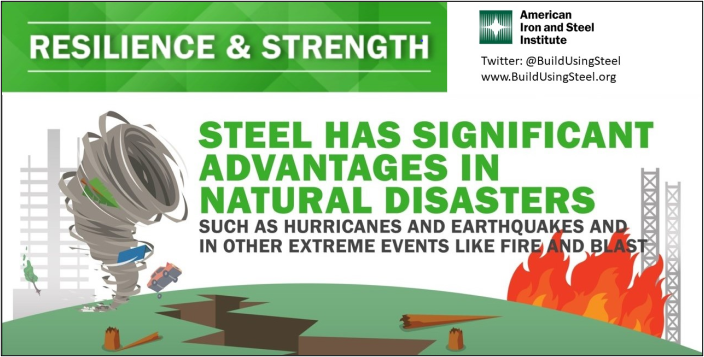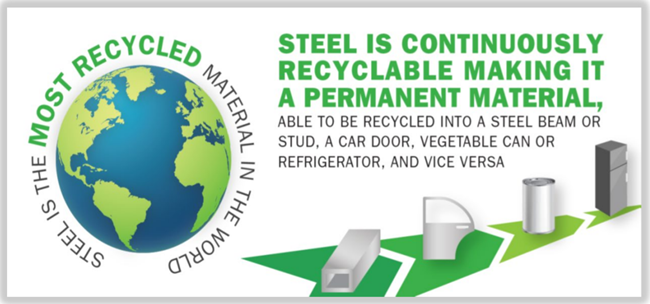
RESILIENCE AND STRENGTH
Communities should be prepared for natural disasters and other extreme events throughout the year, and steel-intensive buildings can play a major role in ensuring they are ready. Resilient building design is considered an important requirement for owners, tenants and building managers -- it goes beyond the minimum code requirements and mitigates the financial and societal costs of operational disruption in the wake of disasters. Here are some ways that steel provides resilience and strength for our communities.

SAMPLE MESSAGING
- Steel’s durability, noncombustibility and strength make it an inherently resilient design material. "Resilience" is defined as a structure’s ability to meet extreme natural and man-made challenges with minimal disruption to occupants and functions.
- Steel's resilient properties make it a cost-effective solution and superior choice for building construction.
- The American steel industry is helping to lead the national trend toward resiliency by developing improved codes and standards and providing guidance to building designers on best practices for steel building systems.
- Steel-intensive structures perform predictably when subjected to the structural loads and movements imposed by natural hazards and man-made events. This is due to steel's homogenous and isotropic properties, dimensional stability and long-term durability. Fasteners, connectors and welds used to join steel framing members also retain their strength, reliability and predictable performance over time. Design professionals can rely on steel for projects in high-seismic, high-wind and other high-challenge areas.
- Of all commonly used construction materials, steel offers the highest tensile strength (i.e., the amount of strain that a material can take before breaking or failing) and is also one of the few materials that is as strong in tension as it is in compression. Steel behaves in a ductile manner, allowing it to effectively respond to the structural loads and movements imposed by extreme events.
- Steel-framed structures are inherently light and, therefore, lower in mass than structures framed with other materials. In a seismic event, structural damage is typically caused by “inertia”, or the reluctance of the building to begin moving as the ground shifts, and then conversely, to stop moving when the ground shifting reverses or stops. Lighter structures have less mass and consequently are subjected to lower forces due to inertia.
- Steel is noncombustible, so it does not contribute to the ignition, spread or size and severity of fires, thus reducing the risks to occupants, firefighters and property/business owners.
- Steel is very effective in blast-resistant applications. Steel frames and systems, designed and detailed for blast loads, are widely used in buildings with special security and physical protection requirements.
- After a flood, it is important that a space be dried out as quickly as possible to mitigate the growth of mold and the effects of water damage. Since steel will not absorb water, it will not retain dampness in the space and won’t serve as a moisture reservoir. Steel is dimensionally stable and will not swell or warp; therefore, walls and floors remain plumb and level even when wet. Unlike wood framing, steel is inorganic and won't provide a source for mold and mildew.
|
RESILIENCE TWEETS
Steel's durability, strength and ductility provide resilience during catastrophic events such as earthquakes, high-wind events, blast events and floods.
Steel's resilient properties make it a cost-effective solution and superior choice for building construction.
The American steel industry is helping to lead the national trend toward resiliency by developing improved codes and standards and providing guidance to building designers on best practices for steel building systems.
Steel-intensive structures perform predictably when subjected to the structural loads and movements imposed by natural hazards and man-made events.
Steel is a smart and reliable material choice in high-seismic, high-wind and other high-challenge areas.
Steel-framed structures are inherently lightweight and ductile, allowing them to attract lower forces and making them less vulnerable during a seismic event.
Following disasters such as earthquakes, steel-intensive buildings are able to remain operational or be restored quickly, so businesses and communities can recover more quickly.
Steel's homogenous and isotropic properties, dimensional stability and long-term durability allow it to behave in a predictable manner when subjected to extreme events throughout the life of the structure.
Steel is noncombustible, so it does not contribute to the ignition, spread or size and severity of fires, thus reducing the risks to occupants, firefighters and property/business owners.
Steel is very effective in blast-resistant applications, making it widely used in buildings with special security and physical protection requirements.
After a flood, it is important that a space be dried out as quickly as possible to mitigate the growth of mold and the effects of water damage. Since steel will not absorb water, it will not retain dampness in the space and won’t serve as a moisture reservoir.
Steel is dimensionally stable and will not swell or warp; therefore, walls and floors remain plumb and level even when wet.
Unlike wood framing, steel is inorganic and won’t provide a source for mold and mildew.